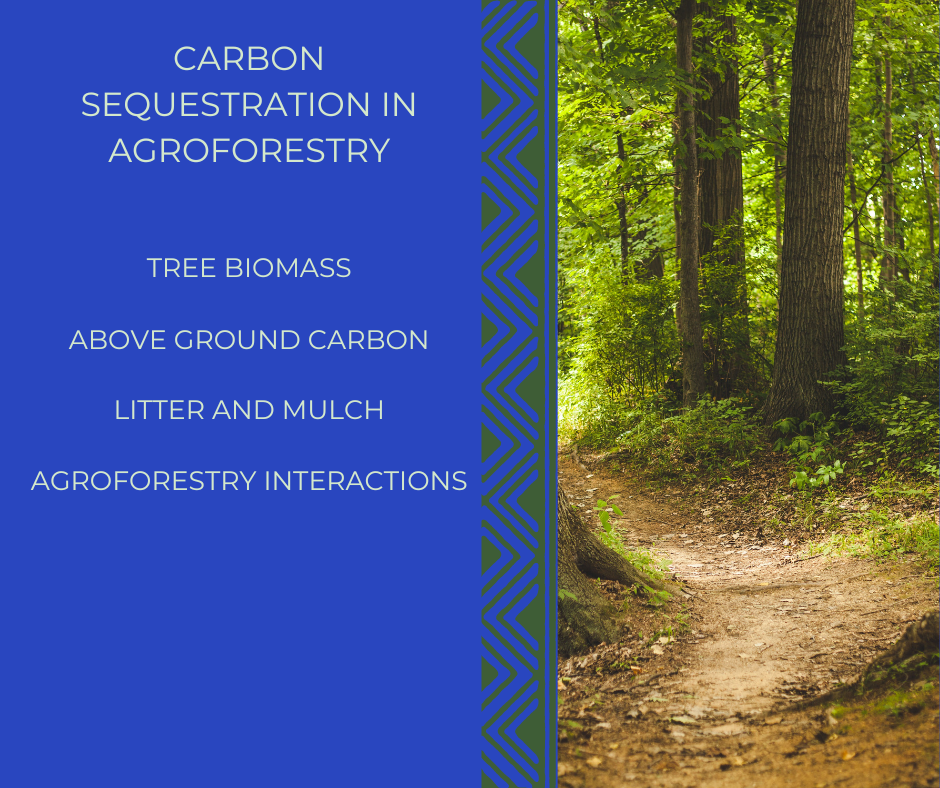Contact: +91 99725 24322 |
Menu
Menu
Quick summary: Discover the power of carbon sequestration in agroforestry and its role in mitigating climate change. Explore the benefits, methods, and best practices in our comprehensive blog. Join the movement towards a greener future with agroforestry and carbon sequestration.

Carbon sequestration in agroforestry is an effective and sustainable approach to climate change mitigation. Carbon sequestration refers to the process of capturing and storing carbon dioxide (CO2) from the atmosphere through the integration of trees in agricultural systems.
Agroforestry combines the cultivation of trees with crops and/or livestock, creating a multifunctional land-use system that provides numerous environmental, social, and economic benefits. The trees in agroforestry systems act as carbon sinks, absorbing CO2 through photosynthesis and storing it in their biomass and in the soil. In this blog, we will explore the science behind carbon sequestration in agroforestry, the types of practices, measuring and monitoring aspects and highlight its environmental benefits.
Agroforestry is a land-use management system that integrates trees with agricultural crops and/or livestock, combining the principles of forestry and agriculture to create sustainable and multifunctional landscapes. The key principles of agroforestry encompass diversity and integration, sustainable land management, and ecological balance. These principles form the foundation for successful agroforestry practices and contribute to the numerous benefits associated with this approach.
One of the fundamental principles of agroforestry is diversity and integration. Agroforestry systems intentionally incorporate a diverse range of tree species, crops, and/or livestock into the landscape. This diversity enhances ecological interactions and promotes resilience in the face of environmental changes. By integrating different components, such as trees with crops or livestock, agroforestry maximizes the productive potential of the land while minimizing risks associated with monocultures. The integration of trees with other elements creates a more complex and productive agroecosystem.
Sustainable land management is another key principle of agroforestry. Agroforestry systems are designed to minimize negative impacts on the land and optimize resource utilization. By incorporating trees, agroforestry helps to prevent soil erosion, improve soil health, and conserve water. The roots of trees help bind the soil, reducing erosion caused by wind and water. The leaf litter and organic matter from trees contribute to soil fertility and nutrient cycling. Agroforestry practices also promote the efficient use of resources, such as water and nutrients, through complementary interactions between tree and crop or livestock components.

Agroforestry practices play a significant role in carbon sequestration by incorporating trees into agricultural landscapes. Agroforestry practices contribute to carbon sequestration through several mechanisms:
There are several types of agroforestry practices, each with its own unique characteristics and benefits. Some common types of agroforestry systems include:
These are just a few examples of agroforestry systems, and variations and combinations of these systems can also be found in different regions around the world.
There are a number of factors to consider when selecting tree species for carbon sequestration. One important factor is the tree’s growth rate. Fast-growing trees can sequester more carbon per unit area than slow-growing trees. Another important factor is the tree’s lifespan. Long-lived trees can store more carbon over time than short-lived trees.
Some of the best tree species for carbon sequestration include:
In addition to selecting the right tree species, it is also important to consider the way in which trees are planted. Trees that are planted close together can form a dense canopy that blocks sunlight and prevents the growth of other plants. This can help to increase the amount of carbon that is sequestered by the trees.
Trees can also be planted in a way that creates windbreaks or shelterbelts. Windbreaks can help to reduce erosion and improve air quality. Shelterbelts can help to protect crops from wind damage.
By selecting the right tree species and planting trees in the right way, it is possible to significantly increase the amount of carbon that is sequestered by forests. This can help to mitigate climate change and improve air quality.
In addition to the factors mentioned above, there are a number of other factors that should be considered when selecting tree species and planting arrangements for maximum carbon sequestration. These factors include:
So, selecting tree species and planting arrangements is vital for maximizing carbon sequestration in agroforestry systems. Choosing tree species with fast growth rates, high biomass production, and longevity, along with considering their specific traits and adaptability, is essential. Moreover, strategic spatial arrangements, integration with crops, and the utilization of edge effects can further enhance carbon sequestration. By implementing these practices, agroforestry systems can effectively contribute to climate change mitigation by capturing and storing significant amounts of carbon dioxide, helping to create a more sustainable and resilient future. Lead magnet
Agroforestry systems have great potential for carbon sequestration, but accurately assessing and monitoring the carbon stocks is crucial for understanding their effectiveness in mitigating climate change. This essay explores the methods, tools, and importance of long-term monitoring for measuring carbon sequestration in agroforestry systems.
By leveraging TraceX’s Sustainability and Carbon management platform, agroforestry practitioners can accurately measure, monitor and report carbon sequestration in their systems. This empowers them to make informed decisions, optimize practices and contribute to climate change mitigation. The platform enables users to establish a baseline by collecting historical data on carbon stock in agroforestry systems and integrate various data sources, like soil sampling and remote sensing to create a comprehensive picture of initial carbon stocks.
The Solution allows users to collect and input data related to tree growth and mortality using user friendly mobile apps. This includes information like tree species, DBH, height and age. By capturing these data points, a comprehensive database is created for tracking individual tree growth and mortality rates. It offers real-time monitoring capabilities to allow users to track tree growth and by recording instances of tree death and associated factors like pest attacks or environmental conditions, it helps to identify potential areas for improvement in these practices.
The platform provides analytic tools to interpret carbon data and generate reports and dashboards to showcase progress, trends and impacts of agroforestry practices. This supports evidence-based decision making and communication with stakeholders. It helps users to generate reports and necessary documentation required for compliance with standards and certification programs.
Agroforestry systems offer significant potential for carbon sequestration, playing a crucial role in mitigating climate change. The integration of trees with agricultural crops and livestock can enhance carbon storage and contribute to sustainable land management practices. Agroforestry promotes the sequestration of carbon in both above-ground biomass and soil, effectively removing carbon dioxide from the atmosphere and storing it for the long term.
The promotion and expansion of agroforestry systems can contribute significantly to global efforts to mitigate climate change. By maximizing carbon sequestration, these systems provide multiple benefits, including improved soil health, biodiversity conservation, enhanced ecosystem services, and sustainable agricultural production.
Agroforestry’s potential for carbon sequestration, combined with its numerous ecological and socio-economic benefits, makes it a compelling solution for achieving a more sustainable and low-carbon future.
